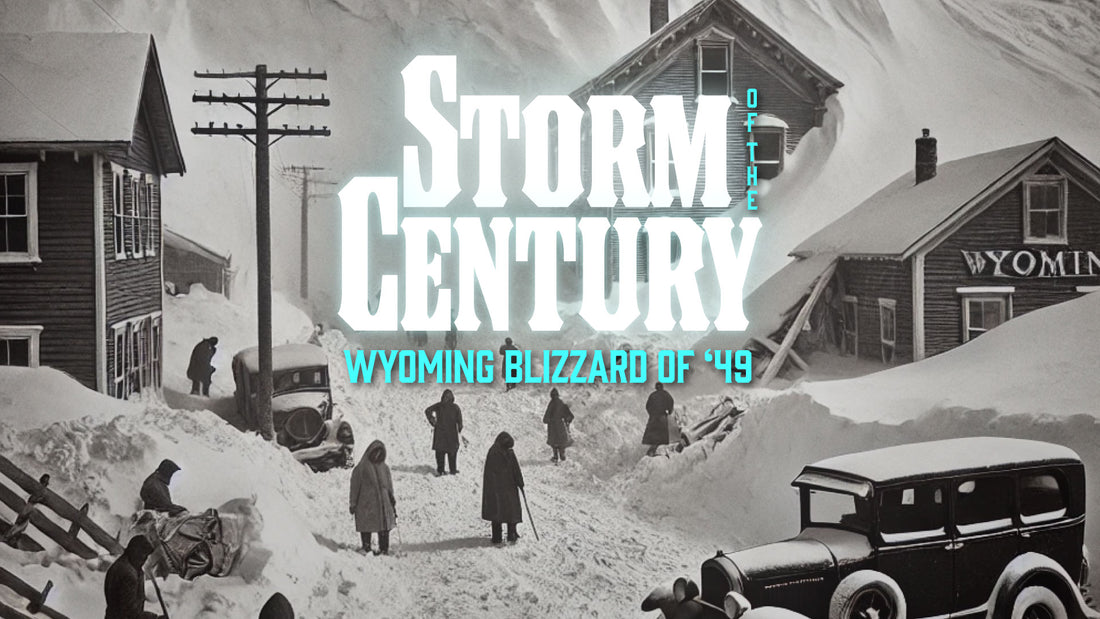
The Blizzard of 1949: Wyoming’s Storm of the Century
The Blizzard of 1949 is remembered as one of the most devastating natural disasters in Wyoming's history. Over six weeks of relentless snowstorms, beginning in early January, blanketed the state and much of the Great Plains. This epic event crippled transportation, strained communities, and caused significant human and economic losses, leaving a legacy of resilience and heroism.
A Storm Unlike Any Other
The blizzard’s fury began on January 2, 1949, when heavy snow combined with winds exceeding 80 miles per hour swept across the region. Temperatures plummeted far below zero, creating whiteout conditions and snowdrifts towering up to 30 feet high. Snow buried roads, railways, and entire buildings, forcing residents to dig tunnels to escape their homes. In some places, even large vehicles like snowplows and bulldozers were immobilized by the sheer volume of snow.
This wasn’t just one storm but a series of blizzards that persisted into February, punctuated by brief lulls. By the time the skies cleared, parts of Wyoming had received up to 30 inches of snow. The drifting snow—propelled by unrelenting winds—created scenes of desolation. Entire towns, like Lusk and Hanna, were engulfed by drifts that climbed as high as 40 feet in some areas.
The Human and Economic Toll
The Blizzard of 1949 took a tragic toll. Seventeen people lost their lives in Wyoming alone, while thousands were stranded on highways, in cars, or aboard halted trains. Stories of heroism and heartbreak emerged. For example, in one tragic case, rescuers found a family frozen in their car, having succumbed to the elements while trying to stay warm with a makeshift fire.
Livestock losses were staggering. The storm killed an estimated 55,000 cattle and over 105,000 sheep, representing 15% of Wyoming’s livestock. This was an enormous blow to the state’s economy, with total damages estimated at $9 million (equivalent to about $110 million today).
Operation Haylift: A Lifeline for Livestock
In the aftermath of the initial storm, emergency response teams launched heroic efforts to deliver aid. The U.S. Air Force initiated “Operation Haylift,” deploying aircraft to drop hay to starving livestock stranded in snowbound pastures. The Wyoming National Guard and local volunteers worked tirelessly, shoveling snow and clearing roads to reach isolated ranches and communities.
Military vehicles, including tanks, were repurposed for rescue and snow-clearing missions. Despite these efforts, many areas remained inaccessible for weeks, underscoring the storm’s unparalleled severity.
Communities Rally Together
Amid the chaos, Wyomingites demonstrated remarkable resilience. Radio stations like KFBC in Cheyenne served as lifelines, broadcasting pleas for help and coordinating relief efforts. Stranded travelers were taken in by ranchers and townspeople, often at great personal sacrifice. Makeshift shelters in homes and public buildings provided warmth and sustenance to those in need.
One memorable story involves 65 men in Goshen County who shoveled their way across 30 miles to rescue a rural family, moving at an arduous pace of one mile per hour. Such acts of bravery exemplified the community spirit that helped Wyoming endure the crisis.
Lessons Learned
The Blizzard of 1949 left an indelible mark on Wyoming and the surrounding region. It highlighted the vulnerability of rural areas to extreme weather and spurred advancements in disaster preparedness. Local and federal governments invested in improved snow-clearing equipment and emergency planning to mitigate the impact of future storms.
A Historic Legacy
Today, the Blizzard of 1949 is remembered not only for its devastation but also for the resilience, resourcefulness, and camaraderie it inspired. It stands as a testament to the enduring spirit of Wyoming’s people, who faced nature’s wrath with determination and solidarity.
As we reflect on this historic event, we honor those who lost their lives and the countless others who fought to save them. The Blizzard of 1949 remains a powerful reminder of the challenges posed by Wyoming’s rugged climate and the strength of its communities in overcoming adversity.
